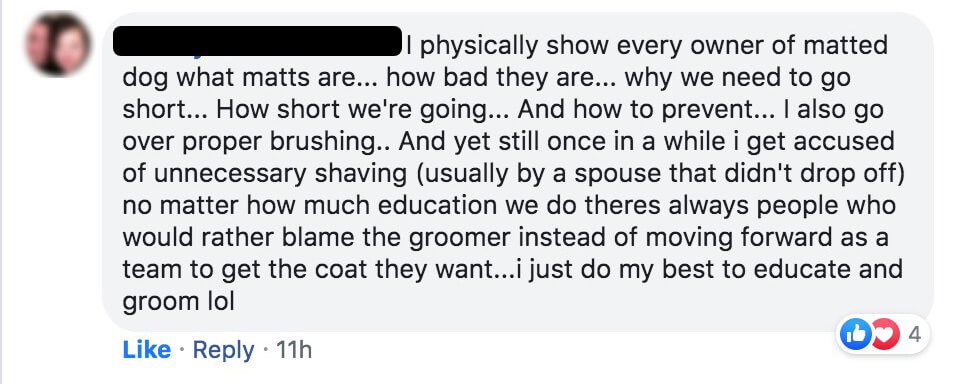Indeed, quite a few professional dog groomers chimed in…





I also appreciated how some groomers mentioned not wanting to create a bad experience for the dog. When they do what’s easiest and the least painful for the dog, they are saving the dog’s lifetime perception of groomers.


Even when a dog has a hair-type coat that can be cut and shaved without permanent damage, shaving does not keep them cooler, it can actually cause sunburn in the summer, overheating, and injury. A Dog’s coat is natural to them. And its a vital (and cuddly!) part of the pets we love. So I’m writing to help us all know how and why to EMBRACE THE COAT your dog has . . . and how to care for it and live with it in a way that gives your dog its best life possible.
Dogs need their coats for protection from the weather – both hot and cold. Coats need to be clean, well-conditioned, mat free, well brushed and combed, regularly de-shed, but they need their coats. A dog’s coat provides insulation both from hot and cold. It keeps them dry, and it protects their largest organ – the skin – from the external environment.
And whereas we have ONE hair per follicle, dogs have on average between 5 and 22 hairs per follicle. They have primary hairs and secondary hairs that lack a cortex. Their hair/fur is in a constant state of rotation between the three growth stages – anagen, catagen, telogen. That is new hairs growing in, old hairs falling out, and mature hairs resting in between. Lots of activity all going on inside one follicle.
The grand exception to all this is a pelted coat (extremely matted in a solid sheet close to the skin) where there is no humane choice for the dog’s comfort but to clip it off. For a haircut type dog, there is no humane option but to shave. But for Fur Type dogs, there are techniques that will allow the natural coat to be mostly saved. We hope that this option is never forced upon you. We would be proud and happy to spend a few minutes in the lobby with you any time to discuss what kind of coat your dog has and what is the long term best care plan for your beloved dog.
Welcome to one of the hottest “inside baseball” debates in the grooming profession. And thanks for listening to my education-explanation as to why we won’t do this at Love Fur Dogs.
Single-coated dogs include dogs such as Greyhounds, Boxers, Dalmatians, Poodles, Maltese, and Afghan Hounds. They can have very short hair or long hair, and it can be wiry, smooth, or curly – but all have even-looking hairs with no soft undercoat.
Temperatures are soaring, your dog is panting, and there’s dog hair all over the house. You might be thinking that a good, close shave down could help cool your dog off while eliminating some of that furry mess.
Rather than shaving your dog, there are some steps you can take to keep him comfortable when the weather is hot:
Dogs also have merocrine sweat glands that function similarly to human sweat glands, however they are located only in a dog’s paw pads, and they activate when the dog is hot to cool him down.
“Your dog’s coat actually acts as an insulator,” explains Dr. Jerry Klein, AKC chief veterinary officer. “Shaving that coat to reduce shedding or supposedly to keep the dog cool also eliminates that insulating layer of fur makes the dog susceptible to heat stroke and can result in improper hair growth and the possibility of follicle damage. A dog’s fur coat protects him from sunburn and decreases his risk of developing skin cancer.”
DEMATTING EXPLAINED – WHY SOMETIMES GROOMERS NEED TO SHAVE YOUR DOG.
Our mission is to help save dogs and cats’ lives through our educational content. To support our efforts, this page may contain affiliate links. We earn a commission for qualifying purchases – at no cost to you.
As Preventive Vets dog behavior expert and lead trainer at Pupstanding Academy, Cathy focuses on helping humans and their pets build a strong relationship based on trust, clear communication, and the use of positive reinforcement and force-free methods. With over 13 years of experience, she has had the opportunity to work with hundreds of dogs on a wide variety of training and behavior issues. Beyond her one-on-one consultations through Pupstanding Academy, she also teaches group dog training classes at Seattle Humane. Her specialties include dog aggression, resource guarding, separation anxiety, and puppy socialization.
Cathy is certified through the Certification Council of Professional Dog Trainers, holding both the CPDT-KA and CBCC-KA designations. Cathy is a Fear Free Certified Certified Professional, a member of the Association of Professional Dog Trainers, the Pet Professional Guild, and the Dog Writers Association of America.
When shes not geeking out about dogs, you can find her reading, hiking with her two Cardigan Welsh Corgis, or paddleboarding.
A note for our readers: If you have an urgent question and are unable to ask your veterinarian, you can use the Ask a Vet service that will give you access to a veterinarian for 7 days for $1.